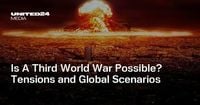As world leaders gathered in Copenhagen on October 2, 2025, the air was thick with urgency—and, for some, dread. The informal summit at Christianborg Palace saw European Union heads of state, joined later by the British prime minister and nearly 40 leaders from the European Political Community, wrestling with a question that has come to define this era: How close are we, really, to a new world war?
At the heart of the summit’s agenda was Ukraine. The European Commission had revived calls to use frozen Russian assets to support Kyiv—a move that immediately drew a sharp response from Moscow. According to reporting by BBC, the Kremlin warned it would “seek to prosecute any such attempt,” a threat that underscores just how fraught the legal and diplomatic landscape has become. The tension wasn’t merely rhetorical; it reflected a world in which the boundaries of war, peace, and economic power are being redrawn in real time.
These high-level discussions in Copenhagen were set against a backdrop of rapidly escalating global military spending. According to the Stockholm International Peace Research Institute, global military expenditures shattered records in 2024, reaching $2.718 trillion, and continued to rise in 2025. Europe and the Middle East led this surge, driven in no small part by the costs of supporting Ukrainian resistance against Russia’s ongoing invasion. NATO, for its part, has set a new long-term goal: by 2035, member states should allocate 5% of GDP to basic defense needs, with the expectation that the previous 2% target will be met much sooner.
This is not just about numbers on a spreadsheet. The US Department of Defense’s 2025 budget, for example, prioritized shipbuilding, air and missile defense, and ammunition production—reflecting both support for Ukraine and lessons learned from the battlefield. One contract alone, a $3.5 billion award to RTX for AMRAAM missiles, is emblematic of a new arms race that feels both familiar and unsettling. European countries are following suit: France is ramping up missile and munitions production, Germany is forecasting a defense budget of 86 billion euros for 2025, and the UK is aiming to spend 2.5% of its GDP on defense by 2027, with a focus on submarine munitions and advanced air defense systems.
Meanwhile, the Indo-Pacific is seeing its own wave of rearmament. Japan has approved a record defense budget, accelerated Tomahawk missile purchases, and invested in long-range strike capabilities. South Korea is pushing ahead with its KF-21 fighter program, and Australia’s choice of the Mogami-class Japanese frigate signals a deepening of naval cooperation among US allies. These moves are, in part, a reaction to China’s growing assertiveness—its 2025 defense budget rose by 7.2%, and there are widespread reports that the official figures understate the true scale of its military expansion.
Russia, for its part, has dramatically increased its defense spending, reaching $462 billion in 2024—a 42% jump in real terms, according to the International Institute for Strategic Studies. Much of this is being poured into the war in Ukraine, particularly drone and missile attacks on civilian targets. The specter of nuclear conflict is never far away; as of January 2025, there were an estimated 12,241 nuclear warheads worldwide, with about 9,600 in military arsenals and 2,100 on high alert, mainly belonging to the US and Russia. China’s nuclear arsenal, meanwhile, grew by roughly 100 warheads in 2024 alone—the fastest expansion among all nuclear states.
Against this backdrop, the Copenhagen summit took on a sense of urgency that went beyond diplomatic niceties. Russia announced that the situation at Europe’s largest nuclear power plant in Zaporizhzhia was “under control” after Ukrainian warnings that the facility had been cut off from external power for several days. Plant management said access would need to be restored soon—a stark reminder of how close the world is to a potential nuclear incident, whether by accident or design.
Ukraine, for its part, marked its annual Defenders Day on October 2. President Volodymyr Zelenskyy delivered an address and met with injured soldiers, a poignant moment that highlighted the ongoing human cost of the conflict. Meanwhile, a Polish court ruled that Volodymyr Z, a Ukrainian diver arrested over suspected Nord Stream sabotage, must remain in custody while his transfer to Germany is decided—a small but telling episode in the broader landscape of hybrid warfare and espionage that now defines the region.
Military analyst Michael Clarke, in his weekly Q&A, suggested that Ukraine might stage another surprise attack before winter, possibly targeting Crimea. He also explained how US Tomahawk long-range missiles, if supplied, could be deployed by Ukrainian forces—a development that would almost certainly provoke a fierce Russian response.
Yet Ukraine is just one flashpoint in a world brimming with them. The Israel-Hezbollah-Iran axis continues to destabilize the Middle East, with arms shipments and rhetoric escalating by the day. Iran’s supply of Shahed drones and missiles to Russia has enabled Moscow to launch relentless attacks on Ukrainian cities, often in “swarms” designed to overwhelm air defenses and terrorize civilians, as detailed by UNITED24 Media. The partnership goes deeper: Iranian specialists are reportedly working with Russians to produce weapons that can strike US bases, a collaboration that has far-reaching implications for global security.
In the Asia-Pacific, tensions between China and Taiwan remain high, with Beijing conducting invasion drills and blockade exercises that many interpret as signals of an imminent attempt at reunification. North Korea, meanwhile, has continued to expand its nuclear program and, in 2024, signed a mutual defense pact with Russia—further intertwining the fates of two of the world’s most unpredictable regimes.
Perhaps the most chilling element of today’s security environment is the normalization of nuclear threats. Russian leader Vladimir Putin has repeatedly warned that any interference in Ukraine could provoke a nuclear response. On September 23, 2025, following a meeting with President Zelenskyy, US President Donald Trump hinted at a shift in US policy toward Ukraine, calling Russia a “paper tiger” and suggesting that Ukraine could not only regain lost territory but “go even further.” Such rhetoric, while intended to project strength, adds another layer of uncertainty to an already volatile situation.
All this raises a sobering question: Are we witnessing the prelude to a Third World War? While no one can say for certain, the convergence of rising military expenditures, intensifying regional conflicts, and the ever-present specter of nuclear escalation has created a world where the possibility can no longer be dismissed as far-fetched. As the Copenhagen summit made clear, the choices made by leaders in the coming months will shape not just the fate of Ukraine, but the stability of the entire international order.
In a world where peace feels increasingly fragile, the urgency for dialogue, restraint, and genuine diplomacy has never been greater.




